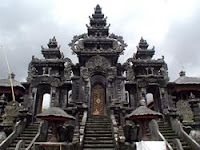Besakih Temple
 Bali's oldest, largest, most impressive and austere temple complex sits one-third the way up the slopes of Gunung Agung. Besakih, actually consisting of three temple compounds, is the Mother Temple of Bali and the most important of the island's Sad Kahyangan religious shrines. It's Bali's supreme holy place, the essence of all Bali's 20,000 temples, a symbol of religious unity, and the only temple that serves all Balinese. It's still spectacular-good energy!
Bali's oldest, largest, most impressive and austere temple complex sits one-third the way up the slopes of Gunung Agung. Besakih, actually consisting of three temple compounds, is the Mother Temple of Bali and the most important of the island's Sad Kahyangan religious shrines. It's Bali's supreme holy place, the essence of all Bali's 20,000 temples, a symbol of religious unity, and the only temple that serves all Balinese. It's still spectacular-good energy!
 Besakih was built on a terraced site where prehistoric rites, ceremonies, and feasts once took place. Perhaps it was here where the spirit of the great, angry mountain, which loomed menacingly above the island, received pagan sacrifices. Certain timeworn megaliths in some of the bale are reminiscent of old Indo-Polynesian structures.
Besakih was built on a terraced site where prehistoric rites, ceremonies, and feasts once took place. Perhaps it was here where the spirit of the great, angry mountain, which loomed menacingly above the island, received pagan sacrifices. Certain timeworn megaliths in some of the bale are reminiscent of old Indo-Polynesian structures.Hindu theologians claim the temple was founded by the 8th century missionary Danghyang Markandeya, a priest credited with introducing the tradition of daily offerings (bebali) and the concept of a single god. His son, Empu Sang Kulputih, was the temple's first high priest.
Besakih is a very complex architectural structure venerating the holy Hindu trinity. Via a series of long stairways, the temple group ascends parallel ridges toward Gunung Agung, the honored birthplace of Bali's deities, tantamount to heaven. The temple is continually enlarged as municipalities, regencies, and wealthy honored Brahman families add more shrines. In fact, each caste and kin group, as well as various sects, artisan guilds, and aristocratic families, maintains its own temple inside the complex.
About 22 separate sanctuaries contain a befuddling array of over 60 temples and 200 distinct structures (a map is posted at the top of the road leading from the parking lot). Given the Balinese passion for covering surfaces with carving or paint, it's remarkable most of Besakih's sanctuaries are constructed simply of wood.




Comments
Post a Comment